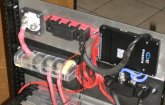MASolarGuy
New Member
- Joined
- Nov 30, 2019
- Messages
- 83
Crimping on large gauge wires only works well if the wire has many fine strands. In many of the installations I worked on in my past, we would use those split bolt wire clamps like the picture Hedges provided. A normal 2/0 THHN wire only has about 19 very stiff thick strands in it. If it was a very high current line, we would sometimes use 2 or even 3 of those clamps along the wires being spliced together to increase the contact area. The lamp in a cinema projector runs at up to 160 amps (about 30-45 volts) and they run all day long. In some cities, they required the power supply to be in a separate room from the projection room due to old school film being flamable. We would have to run up to 4/0 cables to keep the resistance and losses low enough. Sometimes we would get a "brilliant" licensed electrician who would look up the wire ampacity and step it down to a 1/0 without telling anyone. Then we would find the lamps being hard to strike, and flickering once they have a few hours on them, and the electrical contractor was packed up and gone. He saved a ton of money putting in undersized wire, that legally handles the current, but the resistance screwed us. In one job, they also went down a conduit size, so we could not even pull in the right wire later. Thanks to digital projectors, the power supplies are usually in the projector, or the pedestal with less than 6 feet of wire supplied with the projector, but they still run a 6,000 watt Xenon bulb at 160 amps.
Working at high current on a lower voltage makes the wire sizing critical. At 120 volts, a 10 amp load is 1200 watts, and a 0.1 ohm resistance in the circuit will cause a loss of 1 volt or 10 watts, or less than 1%. Even at the same 10 amps at 12 volts, we would still just lose 1 volt, 10 watts, but this is only a 120 watt system, so the loss is 8.3%. And if we actually were trying to get 1200 watts at 12 volts, or 100 amps, that 0.1 ohm loss kills the whole system. 100 amps at 0.1 ohm is 10 volts, so just 2 volts makes it through to the load. Anything less than 120 volt, and the wire sizing really needs to take the voltage drop over distance into consideration.
In this case of a series battery bank, each block of cells is just a 3.6 volt source. At 100 amps, even a tiny bit of resistance can cause a huge loss of power. All of the connections need to be solid.
When I was getting my wire at Home Depot, they had a 25 foot pack of #8 bare copper grounding wire for like $17 You could probably run 4 or 5 of those down your strip between the cells, crimp them into a connector for a 1/0 wire, and then heat it up and fill the dead space with solder. If will be dead stiff, and trying to bend it will probably break out the solder. Even with 4 x #8, I would still connect at both ends of the cell group. At these currents, your 17 cell long row of 18650 cells is going to be about 340 mm long (13.4 inches) and the cells at the far end will end up pulling less current than the ones at the terminal. Connecting at both ends as has been suggested not only cuts the current at each connector in half, it also cuts the length from the furthest cell to the connector in half. The current and voltage balance across the 34 cells will then be much closer.
Thanks for the info GX.
I was talking with a buddy of mine who has me seriously considering switching over to Lifepo4 batteries instead. About the same price, easier to setup, and safer. Ill also end up with around 14kwh vs the 5kwh of this pack.





